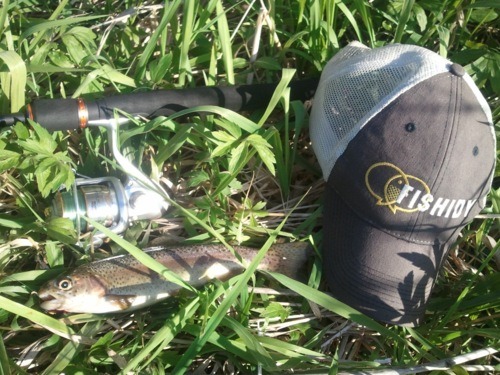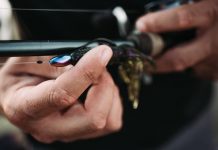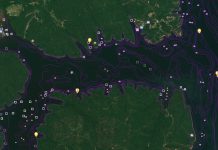
When I was young I learned that if you want to be good at something you have to practice. Since my debut into the trout fishing scene, I’ve gotten quite a few hours logged in my camo waders. In fact, I’ve gone out multiple times in the past few weeks because I’ve become fascinated with the mind of a trout.
Trout are curious creatures. Their main diet consists of other fish, a variety of flies, other insects and some types of worms. Trout longer than 12 inches tend to hone in on “smaller” fish that can be up to 1/3 of their size.
Since they eat such a wide variety of meals, I believe it can be hard to go to a stream with ONLY a fly rod or ONLY a spinning combo and consistently be on fish. This is because both fly and spinning set-ups have their strengths and weaknesses. Now, again, my knowledge on this area is far from an expert, but from fishing streams for the last couple weeks I’ve made a few basic observations. With my good friend, Brian Thiel, using his fly rod and wielding spinning gear myself, I’ve come up with this basic list of pros and cons.
Spinning Rod
Pros:
+ Ability to throw fast moving baits such as in-line spinnerbaits and small crankbaits
+ Can fish with live bait such as night crawlers, minnows, cut bait and smaller worms
+ Fish from shore with ease
+ Low initial cost to everyday fisherman
+ Drag systems on reels
+ Creates reaction strikes
Cons:
– Less accurate casting
– Cost of spinnerbaits > cost of flies
– Cannot cast light-weight flies/lures very well
– Lure entry can create an eruptive splash
– Short periods of time where lure is in strike zones
Fly Rod
Pros:
+ Extreme casting accuracy (if you’re good!)
+ Ability to cast super, light-weight flies long distances
+ Flies are CHEAP!
+ Quiet lure entry
+ Ability to “match the hatch” with flies
+ Flies can be floated in high percentage areas longer
Cons:
– Casting requires a ton of skill and practice!
– Tougher to get deep fish to bite
– More room is needed to cast (this means being in the water most times and an increased chance at spooking fish)
– More “moving parts” such as tippet, reels without drag systems, etc.
– Much more expensive! – $40-50 dollar line, rod, reel, backing, leaders, tippets, strike indicators, waders, net — the list goes on!
Again, I’m not an expert (yet) on this trout fishing stuff, but I feel like between fishing with spinning tackle and watching Brian on the fly rod I’ve gained a ton of knowledge very quickly! We’ve had days where he’s out fished me 2-1 on the flies, and there have been days where I’ve out fished him 5-0 with spinning gear.
It’s become very clear to me that there are better times and places for each, but being able to recognize that is the key to continuously staying on active fish. So far, the spinning tackle has definitely been able to find bigger fish, but there is no doubt in my mind there are many big keepers to be had on the fly rod!
In no time I’ll be one of those newbies with a fly rod, but until then I’ll continue fishing along side my fly rod companion and giving these predators of the stream a run for their money!
Oh and of course, I’m marking all my fly fishing catches on Fishidy.com. Join today and connect with me!




